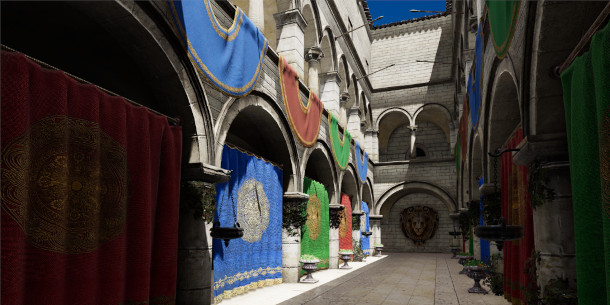Sneak peek: Lumberyard’s new Atom renderer

Amazon has posted a sneak peek at Atom, the new physically based render engine in Lumberyard, its free game engine and development environment.
The renderer, which should be available to test this year, features a modular, data-driven design, and is intended to be “more performant across a wide variety of scenarios, including and beyond gaming”.
A modular render engine configurable by writing JSON files
Amazon describes Atom as having been in development for over three years, which would mean that the firm started work on it not long after the original release of the engine.
The initial blog post focuses mainly on the underlying architecture, describing Atom as a “high-performance physically based renderer” with a highly modular design.
It’s also “entirely data-driven”: interestingly, users can define “almost every feature and configuration” through JSON files rather than conventional coding, reducing the time needed to recompile the engine.
Support for Vulkan and Metal; shading based on Amazon’s own AZSL
Atom supports the DirectX, Vulkan and Metal graphics APIs, and it will be possible to deploy to macOS as well as existing supported platforms like Windows, Linux, Android and iOS.
There’s no mention of current-gen consoles in the blog post – the current release deploys to PlayStation 4 and Xbox One – but Amazon says that there are “more [platforms] to come”.
For shading, Atom uses AZSL (Amazon Shading Language), Amazon’s own extension of DirectX’s HLSL.
The blog post suggests that the syntax changes from standard HLSL are minor: Amazon says that it “saw no need to dramatically reinvent shading language grammars”.

Supports PBR workflows and ray tracing, but limited info on the graphical capabilities
Things get vaguer when it comes to the renderer’s graphical capabilities: there’s no detailed feature list, and no footage of Atom in action, just stills of simple test scenes.
However, the blog post does say that Atom supports physically based shading via a metallic/roughness workflow, including support for multi-layer PBR materials.
That’s a change from the existing specular/glossiness workflow: according to this forum thread, existing materials will need to be converted.
As with Atom’s other features, users can define materials via JSON files, but there will be a node-based material editor at some point: Amazon’s devs are “hard at work designing a node-based graph tool”.
The blog post also mentions that Atom supports GI and ray tracing – replacing the legacy voxel-based GI – plus “several SIGGRAPH technical papers’ worth” of post effects.
Forward+ rendering will be available out of the box, with “the infrastructure to … add deferred rendering”.
Intended for VFX and visualisation as well as games?
Amazon’s blog post suggests that it sees Atom as a platform on which users can build their own advanced features, rather than one that necessarily provides advanced features out of the box.
According to the company, “the greatest visuals and effects won’t come from us. They will come from our customers as they build atop this framework”.
The announcement also pitches Atom at markets “beyond gaming”, with Amazon namechecking use cases including movie visuals, and simulations for automotive and industrial design.
That would be quite an expansion of Lumberyard’s current user base: aside from Amazon Game Studios itself, the only major firm that we’re aware of using the engine is Cloud Imperium Games – the other firms showcased on the Lumberyard YouTube channel are indie studios.
Amazon says that it will provide more details in future blog posts.
Availability and system requirements
Amazon hasn’t announced when Atom will be included in a public release of Lumberyard, but says that users will “have a chance to try” the render engine this year.
The current stable release is Lumberyard 1.27. The editor runs on Windows 7 and above.
The engine is free to use for developing offline and local multiplayer games, including source code access; online games must use Amazon Web Services, charged at Amazon’s standard AWS rates.
Read more about Lumberyard’s upcoming Atom renderer on Amazon’s blog
